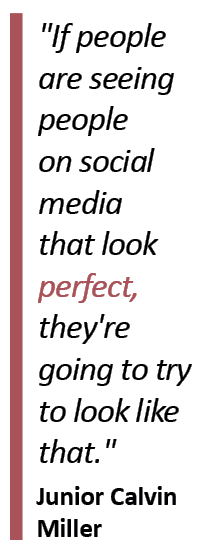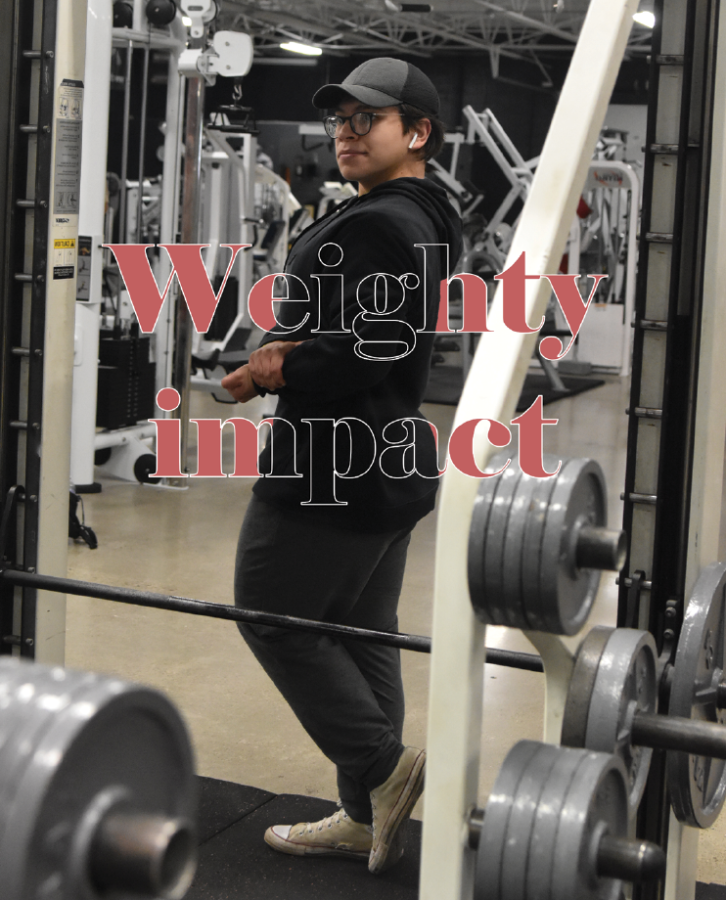Weighty impact
How has gym culture affected students at SHS?
Senior Brandon Carreon looks at himself during his workout on May 13 at American Muscle Factory. Carreon feels most confident at the gym when he has a pump.
As senior Brandon Carreon stares into the mirror after a workout at his gym, he can see his future. He feels all the work he has put in is coming to fruition, and his confidence is high.
However, when he is at home and sees himself in the mirror, much of that confidence dissipates. Carreon feels he hasn’t worked hard enough when he sees his body without the pump of a workout.
 “I feel like I haven’t reached my goal and have gotten smaller,” Carreon said.
“I feel like I haven’t reached my goal and have gotten smaller,” Carreon said.
This phenomenon, body dysmorphia, is all too common amongst lifters. For some, the obsessive focus on physical appearance is brought on by gym culture. But for others, gym culture is the very thing that cures it.
Some people see the gym as a place to work on themselves. Everyone is internally focused, and their mutual goals help gym-goers support one another.
“No one really judges you or pushes you. Everyone’s really chill,” Carreon said. “They let you take your own pace at the gym. … If they see you struggling, they will help you.”
Many amateur lifters find this friendly environment to be incredibly healthy as it gives them a space to feel safe and explore all the aspects of the gym.
Senior Andrea Cerda-Duran started going to the gym consistently earlier this year. She joined to better herself, and since joining, the gym has helped her view herself in a better light.
As a distance runner, she often compared herself to other runners, who she says are typically very thin.
She explained that while the comparison was not constant, it still affected her, causing her to develop body dysmorphia. Since becoming a lifter though, she has felt stronger than ever before.
“I started to feel good,” Cerda-Duran said. “And there were more body types at the gym than the typical runner, and it made me feel more accepting of myself.”
Positive experiences like this shed light on the good that the gym can bring to peoples’ lives.
Despite personal positives, Cerda-Duran also sees some negative effects the gym has on others.
“Some people, they go to the gym to get bigger, to gain more muscle,” Cerda-Duran said. “And I think if that’s their goal, they might compare themselves … , and they might not feel strong enough.”

This perspective opens conversation to a darker side of gym culture, one that perhaps undermines its good outcomes. This dark side shows how something that can be incredibly helpful can also tear people down.Junior baseball player Calvin Miller sees a toxicity in gym culture and believes there is a push to look a certain way.
“People are videotaping themselves trying to get as big as possible, as lean as possible,” Miller said.
Some of the people who record themselves in the gym are “influencers,” who post their videos on social media. Not only can these “influencers” interrupt the flow of the gym, according to Miller, but they can also wreak havoc for people who see their content online. Many times, lifters compare themselves to what they see online.
“If people are seeing people on social media that look perfect, they’re going to try to look like that,” Miller said.
Often, social media lifters use performance enhancing drugs (PEDs), namely steroids such as testosterone, Dianabol and Anavar, to enhance their results. These substances are ingrained in bodybuilding culture and accepted without hesitation. But today, influencers often keep their use of steroids a secret.
This causes people, especially new members, to strive for quick results and perfection. From those misunderstandings, potential health risks become relevant. People are often overly aware of the possible positives and rarely aware of the adverse effects of taking steroids.
“They only see the good parts of steroids,” Carreon said.
The invisible push to be as big as possible, even if unnaturally, is extremely prevalent, according to Miller. Evidence of this push exists at SHS as an anonymous athlete said they would undoubtedly use steroids in the future for their gains.
“Definitely, if it makes me look bigger, I definitely want to,” they said.
With no motivation outside of internal desire, they explained that the reasoning behind this wish was to “feel better about” themselves.
While many see steroids as a necessity to reach their goals, others like Cerda-Duran “don’t really get it.” But, she is able to see how incredibly present their use is in the lifting community.
“They bring bags full of stuff,” Cerda-Duran said.
This situation comes with fear but not without the ability to change.
Responsible influencers have started sharing information about their steroid use. Some talk about blood work and being overseen by medical professionals. This level of transparency is a necessity when information is a priority.
Steroids are built into the foundation of bodybuilding and gym culture. Each lifter has their own experience and can make their own choices in this territory. It’s clear that going to the gym has a huge impact on people. And, with strongly contrasting sides within gyms, each person can choose what they make of their experience. While there is a presence of PEDs, there is also an overarching theme of personal growth.
“In those moments, where you feel small and down, you can look back at your progress and compare that to your body in the present,” Carreon said.

Hello, my name is Noah Daniel. I’ll be serving as both the podcast host and Red Onion editor for The Journal this year. I am a senior at SHS, and it...













